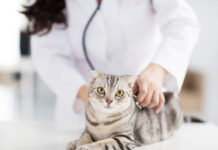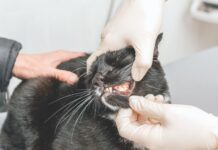A major concern for cat lovers
Q. I just had to euthanize my 10-year-old kitty, Luna, after she developed a fibrosarcoma following a rabies vaccination. I am terribly upset that, in trying to protect her, I may have contributed to her demise. Do I now have to be concerned about my other cats?
A. I am very sorry to hear about your loss, and I am sure that you did everything in your power to make Luna’s life wonderful. Vaccine-associated sarcoma (VAS) is a devastating disease that has become a major concern for cat lovers and veterinary professionals, and research into the mechanism of this condition is ongoing.
The recognition of VAS in cats has had a significant impact on the way that veterinarians view vaccinations and how they should be administered. Since rabies and feline leukemia virus vaccines have been identified as being more likely to result in VAS, the focus has been on these particular vaccines, but VAS may occur after any vaccine.
Vaccines come in a variety of forms. Modified live vaccines (MLV) contain a small quantity of bacteria or virus that has been modified so that it is not capable of causing clinical disease, but can still “infect” an animal. This low dose of infectious agent initiates an immune response, resulting in the production of protective antibodies. While MLV usually produce a robust immune response, they have the potential to mutate to a form of the virus that causes disease, among other problems.
Killed vaccines, in contrast, contain a form of the infectious agent that cannot cause infection but can still initiate an immune response. Killed vaccines are often combined with compounds called adjuvants, which increase the immune response of the patient and the protective immunity imparted by the vaccine. Some studies have implicated adjuvants as the cause of the majority of VAS in cats.
Other studies suggest that VAS may not be due to components of the vaccines themselves, but rather to the inflammation induced by the injections required to deliver vaccines. This hypothesis was raised when VAS were found at non-vaccine injection sites. They have been reported, for example, at the site of microchip insertion. Subsequent studies suggest that these cases may have resulted from vaccines delivered at the same site as the microchip, and this topic remains controversial.
The incidence of VAS in cats is between 1 in 1,000 and 1 in 10,000 vaccines administered, and the average time from vaccination to the development of VAS in cats is between one and three years, although this can vary widely. The diagnosis of VAS involves the identification of a tumor at the site of a previous vaccination, followed by microscopic evaluation of a sample of the tumor (biopsy).
The treatment of VAS consists of aggressive surgical removal of all tumor tissue, followed ideally by radiation and/or chemotherapy. Although surgical removal of VAS can be quite disfiguring due to the aggressiveness of the surgery required, studies have shown that aggressive management can improve the survival of cats diagnosed with VAS. In many cases, however, VAS may recur.
The recognition of VAS in cats has altered vaccine recommendations significantly. These alterations include measures to decrease the frequency of vaccination to the minimal amount necessary to provide protection from infectious disease, case-by-case evaluation of the necessity for each vaccine based upon the living conditions of each cat, and recommendations for where vaccines should be administered so that if a VAS does develop, surgical removal will result in the least possible disfigurement of affected cats.
It is important to remember that while VAS is a risk that should not be discounted, vaccination remains a proven and vital aspect of the maintenance of your kitties’ health. I encourage you to discuss your concerns with your veterinarian and to contact the Cornell Feline Health Center if you have any questions.
I hope that this is helpful and that you will discuss this issue further with your veterinarian. Remember, in spite of the emergence of VAS in cats, vaccination remains a vital component of the health care of cats everywhere —Best regards, Elizabeth ❖



